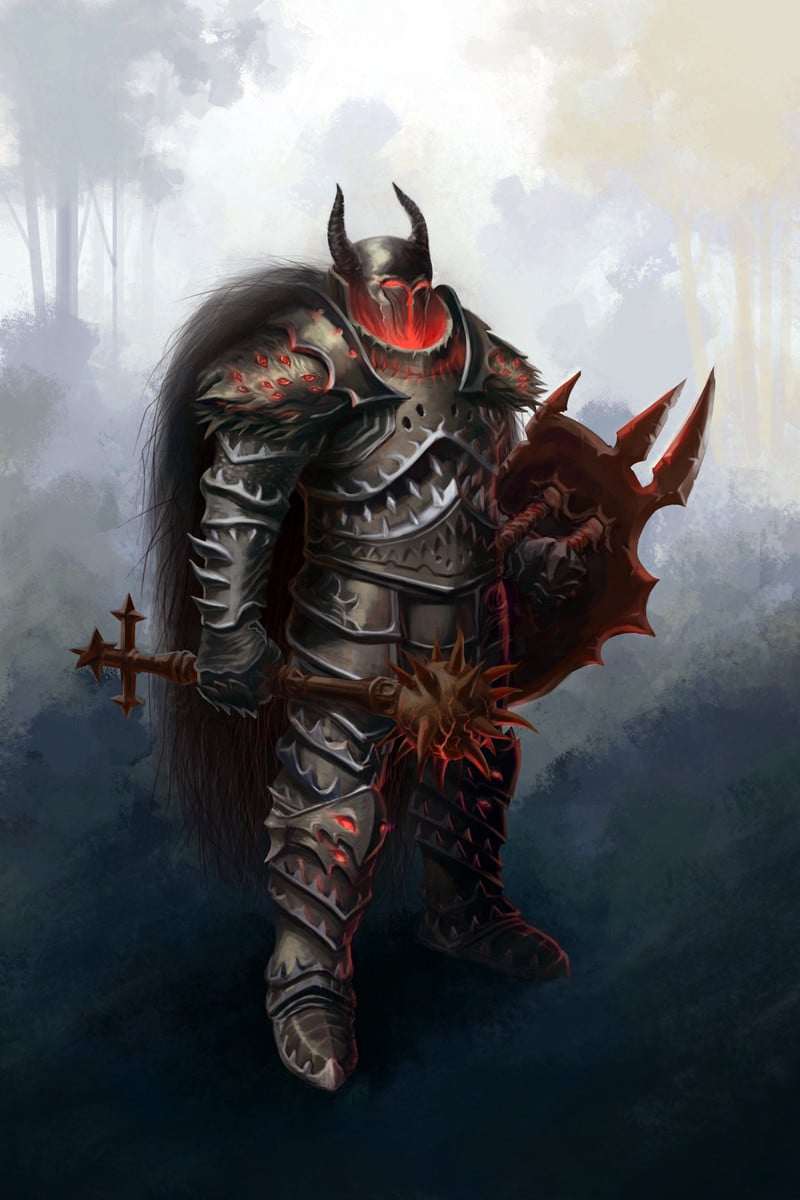Dread Knight (5e Subclass)
Dread Knight[edit]
Fear is a weapon. Dread knights are warriors who accept this simple truth, and use pure fear to their advantage in combat. They understand that if you break the spirit of an enemy, the fight is won even before the first blow is dealt. Thus, dread knights harness the fear in its purest form, by channeling the magical dark forces from the weave trough their bodies and armaments, and creating an aura of terror that paralyzes their foes, rendering them helpless.
The source of a dread knight's power come from magic, and has ties to either the necromancy or enchantment schools of magic. Those who use necromancy can awaken the fear on their subjects by awakening a sense of tangible mortality and proximity to death, the primal source of fear; those who use enchantment will confound and trick the minds of their enemies, causing them to feel as if they were in danger, or manifesting the sources of fear for that creature.
- Terror
Starting at 3rd level, you become able to manifest true terror. You gain a terror die, which is a d4. Whenever you make a Charisma (Intimidation) check, you can use your bonus action to add the terror die to the result of the check.
You can also roll the terror die whenever you make a saving throw to resit the frightened condition, using a reaction to do so.
Some of your features cause damage based on fear. The type of damage depend on your source of fear: necromantic or enchantment. The damage type is psychic (enchantment) or necrotic (necromantic). If a feature require you to roll your terror dice for damage, the damage dealt by the terror die is from the chosen type.
Your terror die increases as you gain levels in this class, becoming a d6 at 5th level, a d8 at 11th level and a d10 at 17th level.
- Terrify
At 3rd level, you can replace any of your attacks made as part of an Attack action for an attempt to terrorize a creature that you can see. The target must succeed on a Wisdom saving throw, or take damage equal to your terror die + your Charisma modifier. The damage type depends on the nature of your fear.
The save DC of this and many other of your Dread Knight class features is calculated as follows: Dread save DC = 8 + your proficiency bonus + your Charisma modifier.
- Menacing
Starting at 3rd level, as a bonus action on your turn, you can make an attempt to demoralize one creature you can see within 30 feet of you that can see and hear you. The target must succeed on a Wisdom saving throw against your Terror save DC. On a failure, the target is frightened until the end of your next turn. If it succeeds, the target can’t be frightened by you in this way for 1 hour.
In addition, if you cause damage to a creature frightened by you, you cause additional damage equal to your terror die. If you cause psychic or necrotic damage (depending on the source of fear chosen), the additional damage equals two terror dice.
- Rooted Fear
At 7th level, creatures with immunity to the frightened condition aren't immune to your terror features, having advantage on saving throws made against your features that impose the frightened condition.
In addition, you ignore resistance to psychic or necrotic damage (the one chosen for terrify), and treat immunity as resistance.
- Paralyzing Fear
At 10th level, any creature frightened by you have its movement speed halved for the duration of the condition.
- Oppressive Aura
Starting at 15th level, any hostile creature in a 10-foot radius around you have a penalty equal to your Charisma modifier (minimum of -1) to their saving throws against the frightened condition.
The creatures you choose in the area gain a bonus equal to your Charisma modifier on saves against the frightened condition.
- Aversion
When you reach the 18th level, you can cast the antipathy/sympathy spell, but only the antipathy effect, centered on yourself. This version can be cast as an action and without requiring any components, and it lasts for 1 hour.
Once you do so, you can't do it again until you finish a long rest.
Back to Main Page → 5e Homebrew → Character Options → Subclasses

